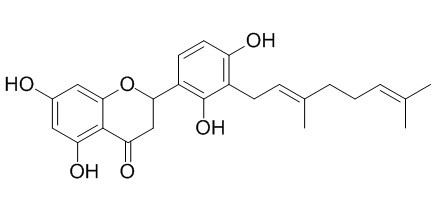Sanggenol A
Sanggenol A shows neuroprotective activity on glutamate-induced cell death in HT22 cells, with EC50 values of 34.03 ± 7.71 uM. Sanggenol A inhibits influenza A viral and pneumococcal neuraminidase (NA), it also disrupts the synergism between influenza A virus and pneumococcal NA in vitro, hence functioning as dual-acting anti-infectives.
Inquire / Order:
manager@chemfaces.com
Technical Inquiries:
service@chemfaces.com
Tel:
+86-27-84237783
Fax:
+86-27-84254680
Address:
1 Building, No. 83, CheCheng Rd., Wuhan Economic and Technological Development Zone, Wuhan, Hubei 430056, PRC
Providing storage is as stated on the product vial and the vial is kept tightly sealed, the product can be stored for up to
24 months(2-8C).
Wherever possible, you should prepare and use solutions on the same day. However, if you need to make up stock solutions in advance, we recommend that you store the solution as aliquots in tightly sealed vials at -20C. Generally, these will be useable for up to two weeks. Before use, and prior to opening the vial we recommend that you allow your product to equilibrate to room temperature for at least 1 hour.
Need more advice on solubility, usage and handling? Please email to: service@chemfaces.com
The packaging of the product may have turned upside down during transportation, resulting in the natural compounds adhering to the neck or cap of the vial. take the vial out of its packaging and gently shake to let the compounds fall to the bottom of the vial. for liquid products, centrifuge at 200-500 RPM to gather the liquid at the bottom of the vial. try to avoid loss or contamination during handling.
Drug Des Devel Ther.2020, 14:5189-5204.
PLoS One.2018, 13(3):e0193386
Antioxidants (Basel).2023, 12(5):1111.
Evid Based Complement Alternat Med.2021, 2021:8707280.
bioRxiv - Molecular Biology2023, 535548.
Nutrients.2020, 12(11):3448.
JMSACL2023, 09.002
American Association for Anatomy2020, doi: 10.1002.
Drug Chem Toxicol.2024, 1-10.
Molecules2020, 25(4):892
Related and Featured Products
Arch Pharm Res. 2015 May 16.
Isoprenylated flavonoids from the root bark of Morus alba and their hepatoprotective and neuroprotective activities.[Pubmed:
25981820]
METHODS AND RESULTS:
A new isoprenylated flavonoid, 2S-5,7,2',4'-tetrahydroxy-3',5'-di-(γ,γ-dimethylallyl)flavanone, sanggenol Q (1), along with seven known isoprenylated flavonoids, Sanggenol A (2), sanggenol L (3), kuwanon T (4), cyclomorusin (5), sanggenon F (6), sanggenol O (7), and sanggenon N (8), three known Diels-Alder type adducts, sanggenon G (9), mulberrofuran G (10), and mulberrofuran C (11), and a known benzofuran, moracin E (12), were isolated from the root bark of Morus alba using silica gel, ODS, and Sephadex LH-20 column chromatography.All compounds were evaluated for hepatoprotective activity on t-BHP-induced oxidative stress in HepG2 cells and neuroprotective activity on glutamate-induced cell death in HT22 cells.
CONCLUSIONS:
Compounds 1, 2, 10, 11, and 12 showed protective effects on glutamate-induced cell death with EC50 values of 5.54 ± 0.86, 34.03 ± 7.71, 19.71 ± 0.71, 16.50 ± 7.82, and 1.02 ± 0.13 μM, respectively.
Sci Rep. 2016 Jun 3;6:27156.
Discovery of prenylated flavonoids with dual activity against influenza virus and Streptococcus pneumoniae.[Pubmed:
27257160]
Influenza virus neuraminidase (NA) is the primary target for influenza therapeutics. Severe complications are often related to secondary pneumonia caused by Streptococcus pneumoniae (pneumococci), which also express NAs. Recently, a NA-mediated lethal synergism between influenza A viruses and pneumococci was described.
METHODS AND RESULTS:
Therefore, dual inhibitors of both viral and bacterial NAs are expected to be advantageous for the treatment of influenza. We investigated the traditional Chinese herbal drug sāng bái pí (mulberry root bark) as source for anti-infectives. Two prenylated flavonoid derivatives, sanggenon G (4) and Sanggenol A (5) inhibited influenza A viral and pneumococcal NAs and, in contrast to the approved NA inhibitor oseltamivir, also planktonic growth and biofilm formation of pneumococci. Evaluation of 27 congeners of 5 revealed a correlation between the degree of prenylation and bioactivity. Abyssinone-V 4'-methyl ether (27) inhibited pneumococcal NA with IC50 = 2.18 μM, pneumococcal growth with MIC = 5.63 μM, and biofilm formation with MBIC = 4.21 μM, without harming lung epithelial cells. Compounds 5 and 27 also disrupt the synergism between influenza A virus and pneumococcal NA in vitro, hence functioning as dual-acting anti-infectives.
CONCLUSIONS:
The results warrant further studies on whether the observed disruption of this synergism is transferable to in vivo systems.
Zhongguo Zhong Yao Za Zhi. 2010 Jun;35(12):1560-5.
New isoprenylated flavonoid from Morus alba.[Pubmed:
20815207]
METHODS AND RESULTS:
Sanggenol P (1), a new isoprenylated flavonoid, together with nine known ones, cyclomorusin (2), morusin (3), mulberrofuran G (4), Sanggenol A (5), sanggenol L (6), sanggenol N (7), cyclomulberrin (8), cyclocommunol (9) and ursolic acid (10) was isolated from Morus alba L. Sanggenol P (1) was characterized based on extensive IR, UV, 1D and 2D NMR spectroscopic analysis.
CONCLUSIONS:
Compounds 5, 6, 7 and 9 were obtained from this plant for the first time.



